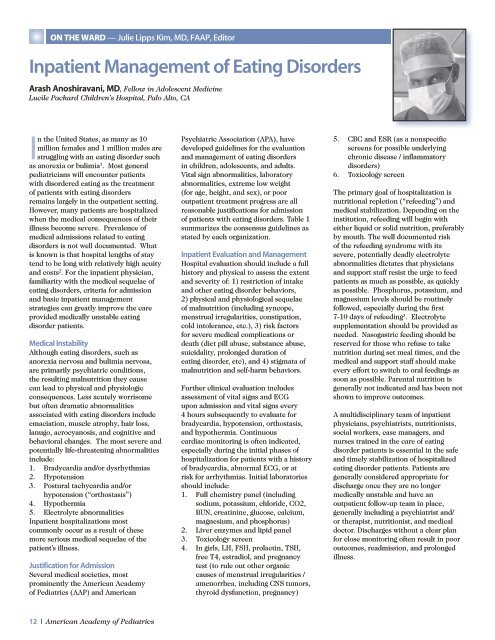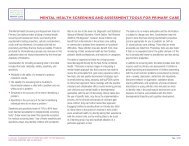Susan Wu, MD, FAAP, Editor - American Academy of Pediatrics
Susan Wu, MD, FAAP, Editor - American Academy of Pediatrics
Susan Wu, MD, FAAP, Editor - American Academy of Pediatrics
Create successful ePaper yourself
Turn your PDF publications into a flip-book with our unique Google optimized e-Paper software.
In the United States, as many as 10<br />
million females and 1 million males are<br />
struggling with an eating disorder such<br />
as anorexia or bulimia 1 . Most general<br />
pediatricians will encounter patients<br />
with disordered eating as the treatment<br />
<strong>of</strong> patients with eating disorders<br />
remains largely in the outpatient setting.<br />
However, many patients are hospitalized<br />
when the medical consequences <strong>of</strong> their<br />
illness become severe. Prevalence <strong>of</strong><br />
medical admissions related to eating<br />
disorders is not well documented. What<br />
is known is that hospital lengths <strong>of</strong> stay<br />
tend to be long with relatively high acuity<br />
and costs 2 . For the inpatient physician,<br />
familiarity with the medical sequelae <strong>of</strong><br />
eating disorders, criteria for admission<br />
and basic inpatient management<br />
strategies can greatly improve the care<br />
provided medically unstable eating<br />
disorder patients.<br />
Medical Instability<br />
Although eating disorders, such as<br />
anorexia nervosa and bulimia nervosa,<br />
are primarily psychiatric conditions,<br />
the resulting malnutrition they cause<br />
can lead to physical and physiologic<br />
consequences. Less acutely worrisome<br />
but <strong>of</strong>ten dramatic abnormalities<br />
associated with eating disorders include<br />
emaciation, muscle atrophy, hair loss,<br />
lanugo, acrocyanosis, and cognitive and<br />
behavioral changes. The most severe and<br />
potentially life-threatening abnormalities<br />
include:<br />
1. Bradycardia and/or dysrhythmias<br />
2. Hypotension<br />
3. Postural tachycardia and/or<br />
hypotension (“orthostasis”)<br />
4. Hypothermia<br />
5.<br />
oN the WarD — Julie Lipps Kim, <strong>MD</strong>, <strong>FAAP</strong>, <strong>Editor</strong><br />
Inpatient Management <strong>of</strong> Eating Disorders<br />
Arash Anoshiravani, <strong>MD</strong>, Fellow in Adolescent Medicine<br />
Lucile Packard Children’s Hospital, Palo Alto, CA<br />
Electrolyte abnormalities<br />
Inpatient hospitalizations most<br />
commonly occur as a result <strong>of</strong> these<br />
more serious medical sequelae <strong>of</strong> the<br />
patient’s illness.<br />
Justification for Admission<br />
Several medical societies, most<br />
prominently the <strong>American</strong> <strong>Academy</strong><br />
<strong>of</strong> <strong>Pediatrics</strong> (AAP) and <strong>American</strong><br />
12 | <strong>American</strong> <strong>Academy</strong> <strong>of</strong> <strong>Pediatrics</strong><br />
Psychiatric Association (APA), have<br />
developed guidelines for the evaluation<br />
and management <strong>of</strong> eating disorders<br />
in children, adolescents, and adults.<br />
Vital sign abnormalities, laboratory<br />
abnormalities, extreme low weight<br />
(for age, height, and sex), or poor<br />
outpatient treatment progress are all<br />
reasonable justifications for admission<br />
<strong>of</strong> patients with eating disorders. Table 1<br />
summarizes the consensus guidelines as<br />
stated by each organization.<br />
Inpatient Evaluation and Management<br />
Hospital evaluation should include a full<br />
history and physical to assess the extent<br />
and severity <strong>of</strong>: 1) restriction <strong>of</strong> intake<br />
and other eating disorder behaviors,<br />
2) physical and physiological sequelae<br />
<strong>of</strong> malnutrition (including syncope,<br />
menstrual irregularities, constipation,<br />
cold intolerance, etc.), 3) risk factors<br />
for severe medical complications or<br />
death (diet pill abuse, substance abuse,<br />
suicidality, prolonged duration <strong>of</strong><br />
eating disorder, etc), and 4) stigmata <strong>of</strong><br />
malnutrition and self-harm behaviors.<br />
Further clinical evaluation includes<br />
assessment <strong>of</strong> vital signs and ECG<br />
upon admission and vital signs every<br />
4 hours subsequently to evaluate for<br />
bradycardia, hypotension, orthostasis,<br />
and hypothermia. Continuous<br />
cardiac monitoring is <strong>of</strong>ten indicated,<br />
especially during the initial phases <strong>of</strong><br />
hospitalization for patients with a history<br />
<strong>of</strong> bradycardia, abnormal ECG, or at<br />
risk for arrhythmias. Initial laboratories<br />
should include:<br />
1.<br />
2.<br />
3.<br />
4.<br />
Full chemistry panel (including<br />
sodium, potassium, chloride, CO2,<br />
BUN, creatinine, glucose, calcium,<br />
magnesium, and phosphorus)<br />
Liver enzymes and lipid panel<br />
Toxicology screen<br />
In girls, LH, FSH, prolactin, TSH,<br />
free T4, estradiol, and pregnancy<br />
test (to rule out other organic<br />
causes <strong>of</strong> menstrual irregularities /<br />
amenorrhea, including CNS tumors,<br />
thyroid dysfunction, pregnancy)<br />
5.<br />
6.<br />
CBC and ESR (as a nonspecific<br />
screens for possible underlying<br />
chronic disease / inflammatory<br />
disorders)<br />
Toxicology screen<br />
The primary goal <strong>of</strong> hospitalization is<br />
nutritional repletion (“refeeding”) and<br />
medical stabilization. Depending on the<br />
institution, refeeding will begin with<br />
either liquid or solid nutrition, preferably<br />
by mouth. The well documented risk<br />
<strong>of</strong> the refeeding syndrome with its<br />
severe, potentially deadly electrolyte<br />
abnormalities dictates that physicians<br />
and support staff resist the urge to feed<br />
patients as much as possible, as quickly<br />
as possible. Phosphorus, potassium, and<br />
magnesium levels should be routinely<br />
followed, especially during the first<br />
7-10 days <strong>of</strong> refeeding 3 . Electrolyte<br />
supplementation should be provided as<br />
needed. Nasogastric feeding should be<br />
reserved for those who refuse to take<br />
nutrition during set meal times, and the<br />
medical and support staff should make<br />
every effort to switch to oral feedings as<br />
soon as possible. Parental nutrition is<br />
generally not indicated and has been not<br />
shown to improve outcomes.<br />
A multidisciplinary team <strong>of</strong> inpatient<br />
physicians, psychiatrists, nutritionists,<br />
social workers, case managers, and<br />
nurses trained in the care <strong>of</strong> eating<br />
disorder patients is essential in the safe<br />
and timely stabilization <strong>of</strong> hospitalized<br />
eating disorder patients. Patients are<br />
generally considered appropriate for<br />
discharge once they are no longer<br />
medically unstable and have an<br />
outpatient follow-up team in place,<br />
generally including a psychiatrist and/<br />
or therapist, nutritionist, and medical<br />
doctor. Discharges without a clear plan<br />
for close monitoring <strong>of</strong>ten result in poor<br />
outcomes, readmission, and prolonged<br />
illness.



